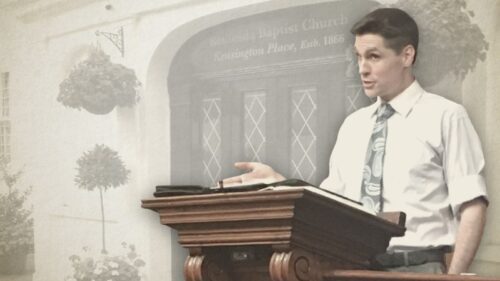9 Bible Doctrine – Who Are The Strict And Particular Baptists?
A Transcript Of The Video Study
In our previous study, I introduced you to a circle of historic churches in England called the Strict and Particular Baptists. From their origin in the early 17th century, this group of churches subscribed to high views of sovereign grace—they were High-Calvinists. Now, you will sometimes hear people tell you that High or Hyper Calvinism represents only a small number of churches during the last several centuries. However, by the turn of the 20th century, there were almost 600 Strict and High-Calvinist Baptists churches scattered around England. This made up one third of all Baptist churches in the country. As you can see from the map, there were 69 chapels in Greater London alone, with another 160 chapels scattered throughout the surrounding counties. You can pause the video and examine the number of Strict and High-Calvinist Baptist chapels in other counties around the country. Of course, the Arminians and Moderate-Calvinists would have you believe High-Calvinist churches have only been few in number, but that is simply untrue. My dear friends, as the map demonstrates, we belong to a long line of faithful believers who shared the same faith and understanding of the gospel as ourselves.
Having said this, these Strict and Particular Baptist men and women are not well known among Christians today. Nowadays, when many Christians think of the outstanding Baptists of earlier centuries, they tend to be more familiar with names such as Andrew Fuller, William Carey and C. H. Spurgeon. These men, however, did not belong to the High-Calvinist circle of churches; they were among the leading figures of the Moderate-Calvinists of their day. For this study, I would like to introduce you to some of the men and women who belonged to the Strict and High-Calvinist Baptist churches—names with which we should all be familiar, as they have bequeathed to us a wealth of information in the form of biographies, sermons and poetry.
We begin with one of the earliest Strict and Particular Baptist preachers named John Skepp (1675-1721). Skepp was converted to Christ under the ministry of a Congregational minister named Joseph Hussey (1660–1726), and though Hussey was not a Strict Baptist, yet I include him on the timeline. Skepp became the pastor of the Baptist congregation meeting at Cripplegate, London, which had been organised by another Strict Baptist pastor named Hanserd Knollys (1599–1691). It was under the ministry of Skepp, that Anne Dutton (1692-1765), a prolific High-Calvinist writer, sharpened her understanding of sovereign grace.
Skepp was also influential in the life and ministry of John Gill (1697-1771). Not only did he take part in Gill’s ordination, but his books on the Hebrew language were acquired by Gill after his death. And it was under the gospel ministry of Gill that John Brine (1703–1765) was converted to Christ. At the age of 27, Brine followed Skepp in the pastorate of the church at Cripplegate, where he served for 35 years. Brine also took part in the ordination of John Ryland Sr. (1723–1792), another Baptist pastor who became a leading advocate of High-Calvinism.
Richard Burnham (1749-1810) served as the pastor of the Strict Baptist church meeting at Grafton Street, Soho. He was a prolific hymn writer, not only publishing his own collections, but having many of his compositions included in other hymn books, such as that of Gadsby’s collection of hymns. After his death, Grafton Street invited John Stevens (1776-1847) to take the pastorate. Stevens is best known for his writings against Andrew Fuller.
Samuel Collins (1799-1881) was converted to Christ under the ministry of John Stevens. In 1826, Collins agreed to become the pastor of the church meeting at Grundisburgh, Suffolk. He enjoyed a fruitful ministry, baptizing around 400 people, training eight men for the gospel ministry and supplying 10 village preaching stations through the efforts of his church. In 1832, he sought to promote the values of the Strict and Particular Baptists by producing a new magazine called, “The Gospel Herald”. For the first several years, he shouldered the entire responsibility of publishing and editing the magazine. I sometimes feel his burden, as I have sought to do something similar through the Association of Historic Baptists.
William Gadsby (1773-1844) was converted to Christ at the age of 17. In addition to becoming the pastor of the Strict Baptist church meeting at Black Lane Chapel, Manchester, he served as an open-air evangelist, traveling over 60,000 miles, preaching over 12,000 sermons, helping to organize more than 40 congregations and taking a keen interest in Sunday Schools. In 1835, he launched the Gospel Standard magazine.
John Warburton (1776-1857) was converted to Christ at the age of 20, under the ministry of a Congregational pastor. Eight years later, he was baptized by William Gadsby in the chapel at Black Lane, Manchester. He became the pastor of Zion Strict Baptist Church, Trowbridge, where he served for 42 years.
John Kershaw (1792-1870) was a close associate of William Gadsby. He became the pastor of the Strict Baptist church meeting at Hope Chapel, Rochdale, where he served for 53 years.
George Wright (1789–1873) was converted to Christ under the ministry of the Weslyian Methodists. However, he was soon convinced of the doctrine of election, and persuaded that only believers were permitted to be baptized. After he was immersed in 1822, he became the pastor of the Strict Baptist church in Beccles.
Philip Dickerson (1795-1882) was the pastor of the Strict Baptist church meeting on Little Alie Street, Whitechapel, London, where he served for 37 years. Incidentally, in 1866, he was one of five pastors to oversee the organizing of a new church meeting in Kensington which would later be named, Bethesda Baptist Church, the congregation that I pastored for twenty years.
Joseph Philpot (1802-1869) was converted to Christ under the personal influence of John Nelson Darby, a central leader among the Plymouth Brethren and the father of modern Dispensationalism. After his conversion, Philpot became the residing curate of two parishes in Oxfordshire. During his 7 year ministry, he met William Tiptaft (1803-1864), and together they grew to nurture high views of sovereign grace. Upon leaving the Church of England, both men were baptized and became pastors of Strict Baptist churches.
Charles Banks (1806 -1886) was converted to Christ and baptized at Canterbury, where he began preaching. After moving to London in 1840, he became the pastor of several churches. In 1845, he started a new magazine called, “The Earthen Vessel”, and became the sole editor until his death, 41 years later.
John Foreman (1792-1872) was for almost 40 years the pastor of the Strict Baptist Church at Hill Street Chapel, Marylebone. He is best known for a book published against duty-faith, which in my opinion excels all other works of its kind, not only encapsulating the essence of High-Calvinism, but unearthing the pernicious roots of Fullerism.
James Wells (1803–1872) was the pastor of the Strict Baptist church meeting in Surrey Tabernacle, Southwark. His congregation was not far from Spurgeon’s Tabernacle, and, as a contemporary with Spurgeon, frequently blasted the Prince of Preachers for his duty-faith and free-offer perversions.
John Hazelton (1822-1888) became the pastor of the Strict Baptist church meeting at Chadwell Street, London, and there remained for 35 years. In 1866, he was another of the five pastors who helped organize Bethesda Baptist into a church, again, the congregation that I pastored for twenty years.
John Booth (1861-1928) was converted to Christ at the age of 20. He became the pastor of Zoar Particular Baptist Chapel, Bradford, where he served for 30 years. This is the church where my good friend, Kevin Price, has been ministering the gospel for many years.
My dear brethren, I hope this introduction to some of the more prominent men and women belonging to the Strict and High-Calvinist Baptists of past centuries has demonstrated the proud legacy and rich heritage they have left for us today. Their names are honorable, insomuch that they were adorned by the gospel of Christ, and their writings are edifying, as they invariably exalted the Savior and magnified the God of all grace.
“So then,” you may ask, “Where can I find their writings?” Well, many of their writings are out of print, but there are ways to track down copies. For instance, with a simple Google search, you can actually obtain free digital copies of many out of print books. You may also want to visit some second hand Christian bookstores, such as the Christian bookshop managed by Jeremy and Lorna Roe in Ossett, England. And just in case you cannot travel that distance to the bookshop, you can visit their website and make an online order. And of course, you may read a wide range of Strict Baptist writings through the online resources of the Association of Historic Baptists, otherwise called the AHB. The AHB is designed to promote the teachings of the Strict and Particular Baptists, by making many of their writings available online.
I certainly hope you will make an effort to familiarize yourself with these High-Calvinist writings, for I believe they will prove a means through which the Lord will build you up in your most holy faith. With that said, I pray you will know the blessings of the Lord for the week ahead, and look forward joining with again for our next study.
Jared Smith
Jared Smith served twenty years as pastor of a Strict and Particular Baptist church in Kensington (London, England). He now serves as an Evangelist in the Philippines, preaching the gospel, organizing churches and training gospel preachers.
Jared Smith on Eldership
Jared Smith on the Biblical Covenants
Jared Smith on the Gospel Law
Jared Smith on the Gospel Message
Jared Smith on Various Issues
Jared Smith, Covenant Baptist Church, Philippines
Jared Smith on Bible Doctrine
Jared Smith on Bible Reading
Jared Smith's Studies in Romans
Jared Smith's Hymn Studies
Jared Smith's Maternal Ancestry (Complete)
Jared Smith's Sermons




